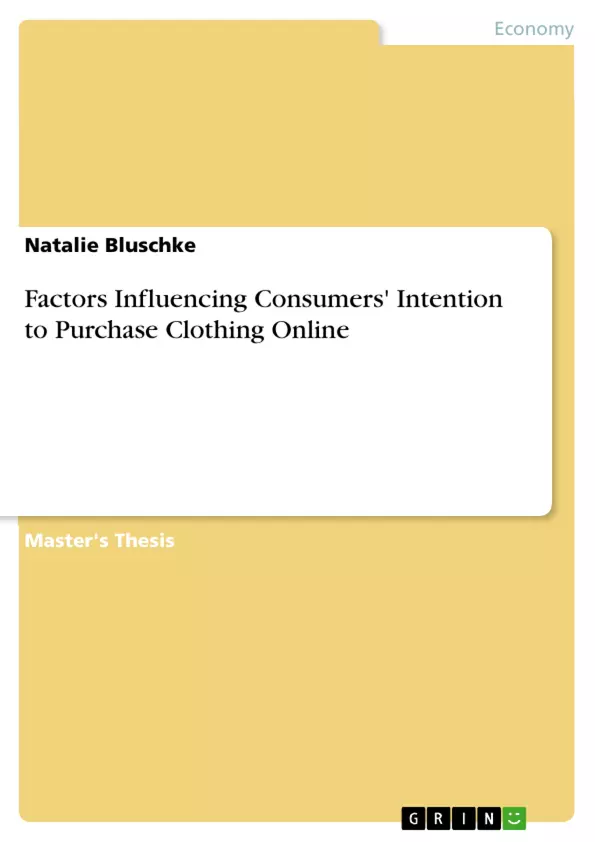
Factors Influencing Consumers' Intention to Purchase Clothing Online
Masterarbeit, 2011
58 Seiten, Note: 1.0
Leseprobe
Table of contents
Acknowledgement
Abstract
CHAPTER
1. Introduction
2. Literature Review
2.1 Online Shopping
2.2 Motives to online shopping
2.3 Barriers to online shopping
2.3.1 Perceived Risk
2.3.2 Online shopping experience
2.4 Underlying framework
2.4.2 Technology Acceptance Model
2.5 Product Involvement
3. Methodology
3.1 Research Instrument
3.2 Sampling
3.3 Measurement and questionnaire design
3.4 Validity and Reliability
3.5 Data analysis
4. Findings and Discussion
4.1 Questionnaire results and analyses
4.2 Online behaviour
4.2.1 Internet use
4.2.2 Online clothing purchases
4.2.3 Online purchases
4.2.4 Intention to purchase clothing online
4.3 Influence of gender
4.4 Evaluation of online shopping
4.5 Testing hypotheses
4.6 Summary and Discussion of findings
5. Conclusion and recommendations
6. Bibliography
7. Appendices
7.1 Appendix 1
7.1.1 Theory of Reasoned Action
7.2 Appendix 2
7.2.1 Questionnaire (piloted version)
7.2.2 Questionnaire (final version)
7.3 Appendix 3
7.3.1 SPSS Findings: Descriptive Statistics
Details
- Titel
- Factors Influencing Consumers' Intention to Purchase Clothing Online
- Hochschule
- Thames Valley University, London
- Note
- 1.0
- Autor
- Natalie Bluschke (Autor:in)
- Erscheinungsjahr
- 2011
- Seiten
- 58
- Katalognummer
- V169957
- ISBN (Buch)
- 9783640884490
- ISBN (eBook)
- 9783640884735
- Dateigröße
- 755 KB
- Sprache
- Englisch
- Schlagworte
- factors influencing consumers intention purchase clothing online
- Produktsicherheit
- GRIN Publishing GmbH
- Preis (Ebook)
- US$ 20,99
- Preis (Book)
- US$ 30,99
- Arbeit zitieren
- Natalie Bluschke (Autor:in), 2011, Factors Influencing Consumers' Intention to Purchase Clothing Online, München, Page::Imprint:: GRINVerlagOHG, https://www.diplomarbeiten24.de/document/169957
- Autor werden
- Ihre Optionen
- Vertriebskanäle
- Premium Services
- Autorenprofil
- Textarten und Formate
- Services für Verlage, Hochschulen, Unternehmen

- © GRIN Publishing GmbH.
- Alle Inhalte urheberrechtlich geschützt. Kopieren und verbreiten untersagt.
- info@grin.com
- AGB
- Open Publishing
Der GRIN Verlag hat sich seit 1998 auf die Veröffentlichung akademischer eBooks und Bücher spezialisiert. Der GRIN Verlag steht damit als erstes Unternehmen für User Generated Quality Content. Die Verlagsseiten GRIN.com, Hausarbeiten.de und Diplomarbeiten24 bieten für Hochschullehrer, Absolventen und Studenten die ideale Plattform, wissenschaftliche Texte wie Hausarbeiten, Referate, Bachelorarbeiten, Masterarbeiten, Diplomarbeiten, Dissertationen und wissenschaftliche Aufsätze einem breiten Publikum zu präsentieren.
Kostenfreie Veröffentlichung: Hausarbeit, Bachelorarbeit, Diplomarbeit, Dissertation, Masterarbeit, Interpretation oder Referat jetzt veröffentlichen!
- GRIN Verlag GmbH
-
- Nymphenburger Str. 86
- 80636
- Munich, Deutschland
- +49 89-550559-0
- +49 89-550559-10
- info@grin.com
-









